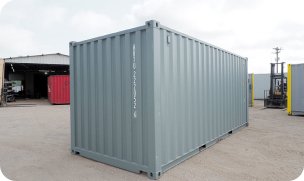If you’re in the market for a storage container, you may be torn between the two main sizes: 20-foot and 40-foot. A 20-foot container may seem ideal for you if you can’t quite fill a 40-foot container (20-foot containers measure about half the cubic volume of a standard 40-foot container).
But there are some times where upgrading to a 40-foot container would be wise. Here are three reasons why.
1. Cost Efficiency
Bottom line is, in most cases, 20-foot containers aren’t very cost-efficient. Since a 20-foot container accommodates half the freight of a 40-foot container, you would assume that a 20-foot container would cost half as much, right? Not so. In fact, to ship a 20-foot container, you’ll actually end up paying up to 75 percent of the cost of a 40-foot container.
Why? Two reasons. One, 20-foot containers need special equipment and handling for the loading process, which is why many freight carriers charge more for this specialty service. Second, you get more value when you ship a larger quantity. Basically, when you buy more, you get a better deal. Just like at those bulk warehouse grocery stores! Or, put it another way: you always get a better deal when buying a six-pack of ginger ale than if you were to buy a single can. You’ll get an even better rate if you buy a 24-pack at the big box store. Same thing with storage containers.
2. Shipping Time
20-foot containers can take longer to ship. Not only do they cost more, they move more slowly than 40-foot containers, especially when transporting by rail. FYI: many freight carriers require 20-foot containers to transport by rail in pairs. So, if no one else decides to ship a 20-foot container when you want to, that container will sit around in the warehouse until the other half of the pair can be found. The result? A delayed shipment that could total weeks.
Also, some carriers are starting to phase out 20-foot containers, which is another good reason to switch to a 40-foot.
3. More Variety
Because every shipment is different, your freight forwarder can customize your package and let you know which solution would be best for your time frame and budget. There are so many other good options available to you that you don’t have to confine yourself to the 20-foot.
The two most common alternatives include:
- You could buy 20 feet of space in a 40-foot container. Once you fill half the container with your stuff, the freight forwarder backfills it with consolidated freight at the warehouse that’s going your same way anyway.
- You could let your freight forwarder handle the whole consolidation from beginning to end. They come to your site, pick up the freight, consolidate it in their warehouse, then transport it all once a complete load is achieved.
In the end, it’s best to work with an experienced freight forwarder who knows your options and what’s best for your needs.
Contact Tropical Trailer Leasing
If you are still undecided whether to go with a 20-foot trailer or a 40-foot trailer, we can help with this decision. We have a variety of storage trailers and shipping containers for you to choose from. Please contact us today in Miami for a free quote at 305-574-9051.


